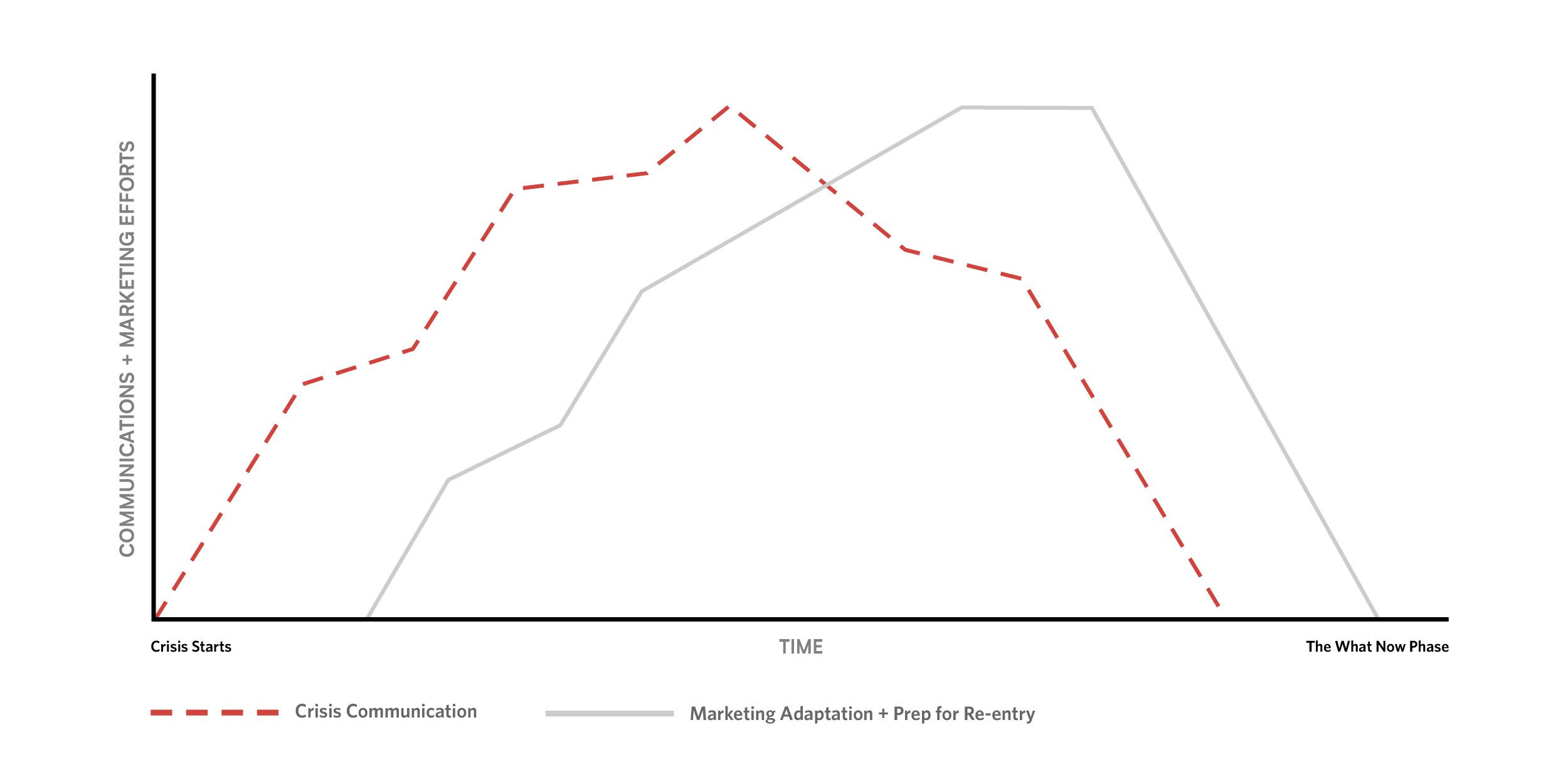
The “What Now?” Phase

KPS3 has been honored to have worked side-by-side with many wonderful clients through these times, helping inform decision-making on crisis communications and, often, marketing strategy adaptations.
Quite an interesting ride it's been the last few weeks. And it looked a bit like this graph.

There comes the immediate spike in efforts on what, how, and when to communicate what your organization is doing about the COVID-19 pandemic—and how it's impacting the business shutdown/slowdown.
We’ve worked with REMSA/Care Flight—our outstanding long-time emergency medical services client here in northern Nevada—because their communications needs skyrocketed immediately and haven’t stopped yet. Because they're on the front-line, whatever we put out needed to be done thoughtfully and quickly. Granted, we had some “non-COVID” projects in the works with them (which are on hold because they have other, life-saving work to do).
For non-healthcare/emergency services clients, we’ve helped pivot their messaging and tailor their approaches to both their audiences. From retail and real estate to tourism and financial advisor services, we worked with speed, but also attention to detail to make sure we had the right tone and the right call to action for the right people. As the country prepares for re-opening and businesses and organizations begin preparations, there will certainly be a need for another wave of communications.
Afterwards, we stepped into the phase of “What Should We Do to Alter Their Marketing?” It was disconcerting given the uncertainty of the end point of the “stay-at-home/close most businesses” phase. Even our appointed officials and their advisors obviously struggled with this. For some of our clients, it was a message change, altering the channel mix, halting existing marketing altogether due to the dire impact on their industry, and moving to channels where we know their audiences are hanging out now (i.e., digital and technology-based channels).
We helped one client, for example, move from solely brick-and-mortar sales to an online shopping platform. This supplemented revenue dramatically over a phone call for orders and pick-up curbside. We're proud to say their website traffic has doubled over the prior year, too.
Clients with more enterprise-level marketing budgets shifted all of their events and other allocations straight into digital. For folks who needed more short-term cash savings, we helped them cut Search Engine Marketing (SEM) and paid digital budgets, keeping only Search Engine Optimization (SEO) the same since this was more of a long-term play. It's kind of like choosing to pay your mortgage, but also to stop spending as much on eating out.
One client cut their SEM budget from in excess of $10,000/month to $1,500/month. In doing so, they went from a broader approach that thinly promoted all of their products to an extremely narrow strategy that promoted a feature of a single product. Their cost-per-lead from those changes went from $200 to $10. By being forced to be more lean, we were also a lot more specific and maximizing budgets.
Now, after the immediate communications and marketing strategy changes occurred, we're entering the “What Now?” phase. So much is dependent on when the economy starts to unfurl again, when people feel confident it is safe to resume prior activities (even if government or science tells them they can, they may not out of fear), and what that timing looks like for each individual industry.
But it’s time (if you haven’t already started) to do contingency work in overall business plans and in marketing and communications plans to support the new overall strategy. Our recommendation would be to develop these for multiple possible scenarios (at least these three) with a phased-in approach to the “new normal” of marketing. Try these:
- Scenario one: The COVID-19 crisis resolves more quickly than anticipated, and the economy opens back up for most industries sooner than economists predict (i.e third quarter or fourth quarter of 2020).
- Scenario two: Many states or local jurisdictions start to open up, but in many cases the public or employers are very hesitant to fully do so because of either altruistic concerns about their employees and customers or because there will be liability issues relating to opening too soon.
- Scenario three: Many states and local jurisdictions start to open up, but it's too soon. The result of this premature release creates a second wave of COVID-19 infections in late 2020 and it’s as bad or worse than the one we're experiencing now.
Choose wisely, grasshopper.
As for messaging, you’ll need to include most of these, depending on your business/industry:
- Your health and safety is our primary concern, and we are implementing proven effective actions to address it.
- Here is our plan to serve you differently during this uncertain time of reopening our community, our state, our nation, our world. Emphasize that you DO have a plan, and it may not have been informed by the perfect crystal ball, but you're going forward based upon research, sound business principles and science.
- Demonstrate how we used/are using our stimulus or other government funding (if you received any) to stay open, pay, and keep our staff while also protecting our customers.
- Explain how we remained and will remain committed to your customers, our communities, and our nation’s health and safety (i.e. what we did and are doing, to give back, pitch in).
Want some advice on when and how to proceed if you own or manage a business or organization?
- Gather good advisors on a number of fronts who can help you wade through all of the research, business projections, marketing strategies, financial options, HR and legal issues, and political machinations that affect your business.
- If you can’t afford those, try to find someone to help without charging you fees via a nonprofit or business organization such as your Chamber of Commerce, SCORE, the Small Business Administration, your professional associations, or other helpful (and valid) resources.
- Study, read, and stay up-to-date on the latest scientific and economic news. Many of your trade or business associations have come up for air and are starting to do research with the target audiences that you’ll want to market to, including perceptions and attitudes about buying from companies in your industry in the short and medium term.
With all of those approaches, use what you find to inform the plan you create to help you out of this crazy mess. It won’t be perfect (because this situation certainly isn’t), but draft a plan that is based upon research, sound information and sage advice, not simply opinion or wishful thinking. KPS3 has been driven by this philosophy for years, and we have been so honored to help our clients do this—before COVID, during COVID, and after COVID.
Stay safe and healthy.